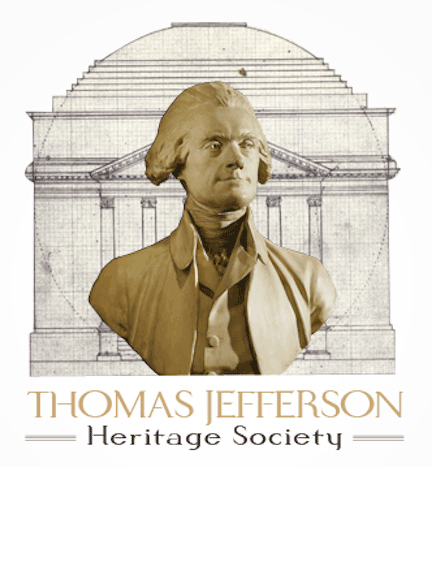The Thomas Jefferson (Memorial) Foundation
The Thomas Jefferson Memorial Foundation was formed in 1923 to preserve and operate Monticello, the home constructed by Thomas Jefferson. In 2000, they dropped the word “Memorial” from their name.
Monticello’s Changed Mission/Vision
In 1954, Monticello’s Constitution provided the original mission / vision for Monticello:
To foster and preserve the Ideals of American liberty and the Republican form of government; and to keep alive the name and memory of Thomas Jefferson, as the apostle of human freedom.
Monticello’s Curator’s Report, 1955, James A. Bear, Jr., Curator
Originally in 2000 the Thomas Jefferson Heritage Society was formed as the Thomas Jefferson Foundation, but Monticello promptly sued the organization in US Federal Court, claiming that the organization’s name was similar to its original name. Outgunning the Thomas Jefferson Heritage Society with high priced well connected lawyers, Monticello prevailed, and then Monticello subsequently changed its name, dropping the word “Memorial” from its official name. See https://www.tjheritage.org/new-tjhs-foundation-formed
Today, the Thomas Jefferson Foundation remains committed to a twofold mission:
- preservation -- to conserve, protect, and maintain Monticello in a manner which leaves it enhanced and unimpaired for future generations -- and
- education -- to interpret and present Thomas Jefferson to the widest possible audiences, including scholars and the general public.
Monticello is a National Historic Landmark, an international Site of Conscience, and the only presidential house in the United States designated a UNESCO World Heritage site.
Vision:
The Thomas Jefferson Foundation seeks to bring history forward into national and global dialogues.
The Foundation seeks to facilitate conversations and to use its extensive research and knowledge to stimulate interactions on a variety of topics that were of keen interest to Jefferson, the most powerful of which are liberty and self government. Through virtual, off-site and on-site engagement, the Foundation seeks to excite the world about Jefferson’s relevance today and ignite a passion for history.
Following the link to the "Site of Conscience" website, on their “About Us” page, describes what a “Site of Conscience” is--https://www.sitesofconscience.org/about-us/about-us-2/
A Site of Conscience is a place of memory – such as a historic site, place-based museum or memorial – that prevents this erasure from happening in order to foster more just and humane societies today. Not only do Sites of Conscience provide safe spaces to remember and preserve even the most traumatic memories, but they enable their visitors to make connections between the past and related contemporary human rights issues.
But where are all these "traumatic memories" that have been documented at Monticello to merit this distinction?
James Madison’s Montpelier also is a "site of conscience" featured on the website of the International Coalition of Sites of Conscience --but George Washington’s Mt. Vernon is not. See also A Tale of Three Presidential Houses: The Good, the Bad, and the Ugly
Francis L. Berkeley Interview
Mr. Berkeley was Curator of Manuscripts at the University of Virginia (UVA) for more than 25 years and was a member of the Thomas Jefferson Memorial Foundation Board for approximately 29 years. He contributed to the preservation of important family papers by attaining them for safe keeping and future use in the library. See A Guide to the Papers of Francis L. Berkeley Jr.1935-2005 Berkeley, Francis L., Jr., Papers 12747-b,-c,-d (virginia.edu)
Over a 25 year period, Mr. Berkeley compiled an extensive file about the Hemings, particularly Sally Hemings. Mr. Berkeley's standing order was that any collection that came in from any Central Virginia county was to be examined with special care for any references to the Hemings, especially Sally Hemings. This Sally Hemings file is now missing from UVA’s library.
This summary was prepared by Frank Buell, son-in-law of Herbert Barger, Jefferson Family Historian. It is based on an audio taped interview of Mr. Francis L. Berkeley conducted by Mr. Barger taken on March 29, 2000.
This is a direct link to the Memorial Foundation’s Research Committee Report which concluded that Jefferson probably fathered a child by Sally Hemings. Report of the Research Committee on Thomas Jefferson and Sally Hemings (January 2000)
Minority dissenting report by White McKenzie (Ken) Wallenborn, MD of the conclusions of the Memorial Foundation concerning the Jefferson-Hemings issue. Minority Report of the Monticello Research Committee on Thomas Jefferson and Sally Hemings (March 23, 2000)
The Memorial Foundation prepared a response to its own minority report. Response to the Minority Report (May 18, 2000)
Reply by Dr. Wallenborn to the Memorial Foundation in response to their comments on his Minority Report. Reply to the Response to the Minority Report (July 28, 2000)

